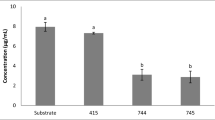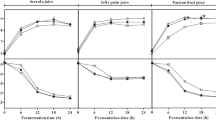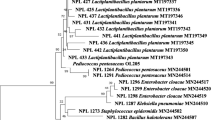Abstract
This study examines the influence of lactic acid fermentation on iridoid and polyphenolic compounds in unripe Cornus mas L. fruits. Fermentation was carried out at room temperature over 6 weeks. Eight versions of the fermentation process were conducted: with inoculation by microflora isolated from black olives, Lb. brevis 18 M, Lb. casei 0919, Lb. paracasei 920, Lb. rhamnosus 0900, Lb. rhamnosus 0908, and spontaneous fermentation with and without summer savory (Satureja hortensis). The polyphenolic compounds, iridoids and antioxidant activities were examined in the products obtained. After fermentation, the polyphenols detected were: gallic acid and one of its derivatives, protocatechuic and ellagic acids, neochlorogenic and chlorogenic acids, and a chlorogenic acid derivative. Loganic acid and cornuside were found to be present in both the fermented fruits and the brines. The tested microorganisms produced varying amounts of lactic acid and had varying degrees of impact on the content of biologically active compounds. Lb. rhamnosus 908 proved to be the most effective strain. Unripe cornelian cherries fermented with probiotic strains could be used as an innovative pro-health product.
Similar content being viewed by others

References
Abriouel H, Benomar N, Cobo A, Caballero N, Fernández Fuentes MA, Pérez-Pulido R, Gálvez A (2012) Characterization of lactic acid bacteria from naturally fermented Manzanilla Aloreña green table olives. Food Microbiol 32:308–316
Alberto MR, Farías ME, Manca de Nadra MC (2001) Effect of gallic acid and catechin on Lactobacillus hilgardii 5w growth and metabolism. J Agric Food Chem 49:4359–4363
Aleksandrzak-Piekarczyk T, Koryszewska-Baginska A, Bardowski J (2013) Genome sequence of the probiotic strain Lactobacillus rhamnosus (Formerly Lactobacillus casei) LOCK900. Genome Announc 1(4):5
Argyri A, Zoumpopoulou G, Karatzas KA, Tsakalidou E, Nychas G-JE, Panagou EZ, Tassou CC (2013) Selection of potential probiotic lactic acid bacteria from fermented olives by in vitro tests. Food Microbiol 33:282–291
Arroyo-López FN, Querol A, Bautista-Gallego J, Garrido-Fernández A (2008) Role of yeasts in table olive production. Int J Food Microbiol 128:189–196
Arroyo-López FN, Romero-Gil V, Bautista-Gallego J, Rodríguez-Gómez F, Jiménez-Díaz R, García-García P, Querol A, Garrido-Fernández A (2012) Yeasts in table olive processing: Desirable or spoilage microorganisms? Int J Food Microbiol 160:42–49
Bautista-Gallego J, Arroyo-López FN, Rantsiou K, Jiménez-Díaz R, Garrido-Fernández A, Cocolin L (2013) Screening of lactic acid bacteria isolated from fermented table olives with probiotic potential. Food Res Int 50:135–142
Benzie IEF, Strain JJ (1996) The ferric reducing ability of plasma (FRAP) as a measure of “antioxidant power”. The FRAP assay. Anal Biochem 239:70–76
Blana VA, Grounta A, Tassou CC, Nychas G-JE, Panagou EZ (2014) Inoculated fermentation of green olives with potential probiotic Lactobacillus pentosus and Lactobacillus plantarum starter cultures isolated from industrially fermented olives. Food Microbiol 38:208–218
Campos FM, Couto JA, Figuereido AR, Toth IV, Rangel AOSS, Hogg TA (2009) Cell membrane damage induced by phenolic acids on wine lactic acid bacteria. Int J Food Microbiol 135:144–151
Curiel JA, Rodriguez H, Landete JM, de las Rives B, Munoz R (2010) Ability of Lactobacillus brevis strains to degrade food phenolic acids. Food Chem 120:225–229
Deng S, West BJ, Jarakae Jensen C (2013) UPLC-TOF-MS characterization and identification of bioactive iridoids in Cornus mas fruit. J Anal Methods Chem. doi:10.1155/2013/710972
Dewick PM (2009) Medicinal natural products. A biosynthetic approach. Wiley, New York
Filannino P, Gobbetti M, de Angelis M, Di Cagno R (2014) Hydroxycinnamic acids used as external acceptors of electrons: an energetic advantage for strictly hetero-fermentative lactic acid bacteria. Appl Environ Microbiol 80:7574–7582
Hatano T, Yasuhara T, Abe R, Okuda T (1990) A galloylated monoterpene glucoside and a dimeric hydrolysable tannin from Cornus officinalis. Phytochemistry 29:2975–2978
Hurtado A, Reguant C, Bordons A, Rozes N (2009) Influence of fruit ripeness and salt concentration on the microbial processing of Arbequina table olives. Food Microbiol 26:827–833
Koryszewska-Baginska A, Aleksandrzak-Piekarczyk T, Bardowski J (2013) Complete genome sequence of the probiotic strain Lactobacillus casei (Formerly Lactobacillus paracasei) LOCK919. Genome Announc 1(5):26
Koryszewska-Baginska A, Bardowski J, Aleksandrzak-Piekarczyk T (2014) Genome Sequence of the Probiotic Strain Lactobacillus rhamnosus (Formerly Lactobacillus casei) LOCK908. Genome Announc 2(1):20
Kucharska AZ (2012) Active compounds of cornelian cherry fruit (Cornus mas L.). Wydawnictwo Uniwersytetu Przyrodniczego, Wrocław
Kucharska AZ, Piórecki N, Sokół-Łętowska A, Żarowska B (2011) Characteristics of chemical composition and antioxidant properties of cornelian cherry fruit fermented in brine. Zeszyty Problemowe Postępów Nauk Rolniczych 566:125–133
Kucharska AZ, Szumny A, Sokół-Łętowska A, Piórecki N, Klymenko SV (2015) Iridoids and anthocyanins in cornelian cherry (Cornus mas L.) cultivars. J Food Compos Anal 40:95–102
Landete JM, Rodrıguez H, de las Rives B, Munoz R (2007) High added-value antioxidants obtained from the degradation of wine phenolics by Lactobacillus plantarum. J Food Prot 70:2670–2675
Landete JM, Curiel JA, Rodriguez H, de las Rives B, Munoz R (2008) Study of the inhibitory activity of phenolic compounds found in olive products and their degradation by Lactobacillus plantarum strains. Food Chem 107:320–326
Landete JM, Rodrıguez H, Curiel JA, de las Rives B, Munoz R (2010) Gene cloning, expression, and characterization of phenolic acid decarboxylase from Lactobacillus brevis RM84. J Ind Microbiol Biotechnol 37:617–624
Marazza JA, Garro MS, de Giori GS (2009) Aglycone production by Lactobacillus rhamnosus CRL981 during soymilk fermentation. Food Microbiol 26:333–339
Re R, Pellegrini N, Poteggente A, Pannala A, Yang M, Rice-Evans C (1999) Antioxidant activity applying an improved ABTS radical cation decolorization assay. Free Radic Biol Med 26:1321–1327
Rivas-Sendra A, Landete JM, Alcantara C, Zuniga M (2011) Response of Lactobacillus casei BL23 to phenolic compounds. J Appl Microbiol 111:1473–1481
Ruiz-Barba JL, Brenes-Balbuena M, Jiménez-Díaz R, García-García P, Garrido Fernández A (1993) Inhibition of Lactobacillus plantarum by polyphenols extracted from two different kind of olive brine. J Appl Bacteriol 74:15–19
Settanni L, Moschetti G (2014) New trends in technology and identity of traditional dairy and fermented meat production processes. Trends Food Sci Technol 37:51–58
Sisto A, Lavermicocca P (2012) Suitability of a probiotic Lactobacillus paracasei strain as a starter culture in olive fermentation and development of the innovative patented product “probiotic table olives”. Front Microbiol. doi:10.3389/fmicb.2012.00174
Sokół-Łętowska A, Kucharska AZ, Wińska K, Szumny A, Nawirska-Olszańska A, Mizgier P, Wyspiańska D (2014) Composition and antioxidant activity of red fruit liqueurs. Food Chem 157:533–539
Stead D (1994) The effect of chlorogenic, gallic and quinic acids on the growth of spoilage strains of Lactobacillus collinoides and Lactobacillus brevis. Lett Appl Microbiol 18:112–114
Yen GC, Chen HY (1995) Antioxidant activity of various tea extracts in relation to their antimutagenicity. J Agric Food Chem 43:27–32
Author information
Authors and Affiliations
Corresponding author
Rights and permissions
About this article
Cite this article
Czyżowska, A., Kucharska, A.Z., Nowak, A. et al. Suitability of the probiotic lactic acid bacteria strains as the starter cultures in unripe cornelian cherry (Cornus mas L.) fermentation. J Food Sci Technol 54, 2936–2946 (2017). https://doi.org/10.1007/s13197-017-2732-3
Revised:
Accepted:
Published:
Issue Date:
DOI: https://doi.org/10.1007/s13197-017-2732-3



